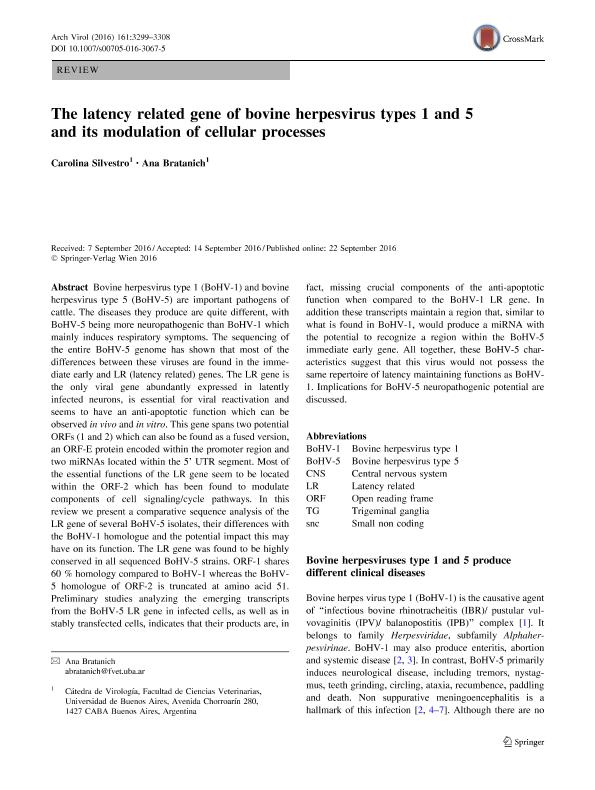Mostrar el registro sencillo del ítem
dc.contributor.author
Silvestro, Carolina

dc.contributor.author
Bratanich, Ana Cristina

dc.date.available
2018-07-05T20:56:01Z
dc.date.issued
2016-12
dc.identifier.citation
Silvestro, Carolina; Bratanich, Ana Cristina; The latency related gene of bovine herpesvirus types 1 and 5 and its modulation of cellular processes; Springer Wien; Archives of Virology; 161; 12; 12-2016; 3299-3308
dc.identifier.issn
0304-8608
dc.identifier.uri
http://hdl.handle.net/11336/51446
dc.description.abstract
Bovine herpesvirus type 1 (BoHV-1) and bovine herpesvirus type 5 (BoHV-5) are important pathogens of cattle. The diseases they produce are quite different, with BoHV-5 being more neuropathogenic than BoHV-1 which mainly induces respiratory symptoms. The sequencing of the entire BoHV-5 genome has shown that most of the differences between these viruses are found in the immediate early and LR (latency related) genes. The LR gene is the only viral gene abundantly expressed in latently infected neurons, is essential for viral reactivation and seems to have an anti-apoptotic function which can be observed in vivo and in vitro. This gene spans two potential ORFs (1 and 2) which can also be found as a fused version, an ORF-E protein encoded within the promoter region and two miRNAs located within the 5’ UTR segment. Most of the essential functions of the LR gene seem to be located within the ORF-2 which has been found to modulate components of cell signaling/cycle pathways. In this review we present a comparative sequence analysis of the LR gene of several BoHV-5 isolates, their differences with the BoHV-1 homologue and the potential impact this may have on its function. The LR gene was found to be highly conserved in all sequenced BoHV-5 strains. ORF-1 shares 60 % homology compared to BoHV-1 whereas the BoHV-5 homologue of ORF-2 is truncated at amino acid 51. Preliminary studies analyzing the emerging transcripts from the BoHV-5 LR gene in infected cells, as well as in stably transfected cells, indicates that their products are, in fact, missing crucial components of the anti-apoptotic function when compared to the BoHV-1 LR gene. In addition these transcripts maintain a region that, similar to what is found in BoHV-1, would produce a miRNA with the potential to recognize a region within the BoHV-5 immediate early gene. All together, these BoHV-5 characteristics suggest that this virus would not possess the same repertoire of latency maintaining functions as BoHV-1. Implications for BoHV-5 neuropathogenic potential are discussed.
dc.format
application/pdf
dc.language.iso
eng
dc.publisher
Springer Wien

dc.rights
info:eu-repo/semantics/openAccess
dc.rights.uri
https://creativecommons.org/licenses/by-nc-sa/2.5/ar/
dc.subject
Bovine Herpesvirus
dc.subject
Latency
dc.subject
Lr Gene
dc.subject
Neuropathogeny
dc.subject
Trigeminal Ganglion
dc.subject
Trigeminal Ganglion Neuron
dc.subject
Mdbk Cell
dc.subject
Mouse Neuroblastoma Cell
dc.subject
Lytic Infection
dc.subject.classification
Otras Ciencias Veterinarias

dc.subject.classification
Ciencias Veterinarias

dc.subject.classification
CIENCIAS AGRÍCOLAS

dc.title
The latency related gene of bovine herpesvirus types 1 and 5 and its modulation of cellular processes
dc.type
info:eu-repo/semantics/article
dc.type
info:ar-repo/semantics/artículo
dc.type
info:eu-repo/semantics/publishedVersion
dc.date.updated
2018-06-22T14:33:38Z
dc.identifier.eissn
1432-8798
dc.journal.volume
161
dc.journal.number
12
dc.journal.pagination
3299-3308
dc.journal.pais
Austria

dc.journal.ciudad
Viena
dc.description.fil
Fil: Silvestro, Carolina. Consejo Nacional de Investigaciones Científicas y Técnicas. Oficina de Coordinación Administrativa Parque Centenario; Argentina. Universidad de Buenos Aires. Facultad de Ciencias Veterinarias. Departamento Virologia; Argentina
dc.description.fil
Fil: Bratanich, Ana Cristina. Consejo Nacional de Investigaciones Científicas y Técnicas. Oficina de Coordinación Administrativa Parque Centenario; Argentina. Universidad de Buenos Aires. Facultad de Ciencias Veterinarias. Departamento Virologia; Argentina
dc.journal.title
Archives of Virology

dc.relation.alternativeid
info:eu-repo/semantics/altIdentifier/url/http://link.springer.com/article/10.1007/s00705-016-3067-5
dc.relation.alternativeid
info:eu-repo/semantics/altIdentifier/doi/http://dx.doi.org/10.1007/s00705-016-3067-5
Archivos asociados
